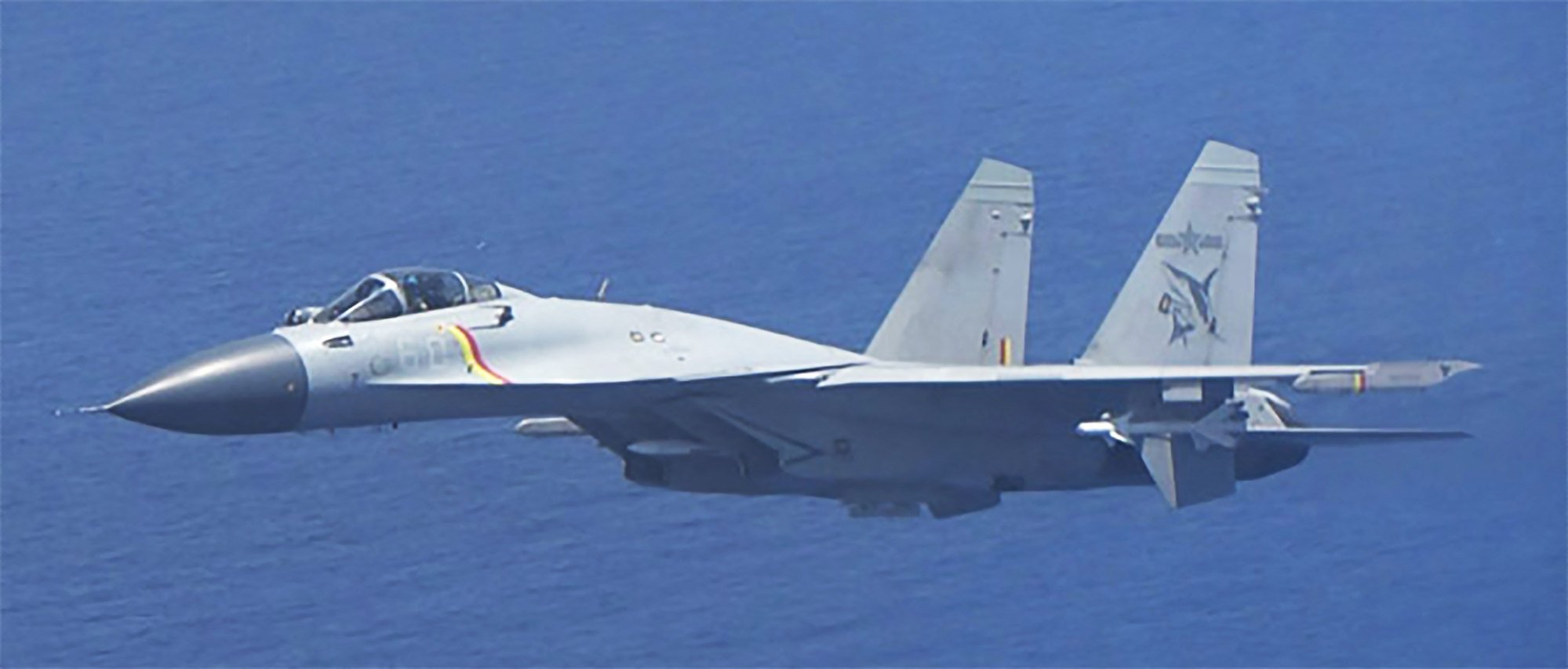Japan warns of collision risks after Chinese fighter jet manoeuvres
Such actions by the Chinese jet should be viewed as ‘threats’, as any error could escalate tensions in the Pacific, analysts say

Japan has expressed serious concerns to Beijing through diplomatic and defence channels after a Chinese fighter jet from the aircraft carrier Shandong made “abnormal approaches” to a Japanese patrol aircraft over the Pacific Ocean.
In a statement, Tokyo’s defence ministry said a J-15 fighter shadowed its P-3C patrol aircraft operating over the Pacific for about 40 minutes from 10.30am on Saturday and again for around 80 minutes from 2pm on Sunday.
The ministry said the Chinese fighter approached close to a horizontal distance of about 45 metres with no altitude difference and, in another manoeuvre on Sunday, “crossed approximately 900 metres ahead of the patrol aircraft’s course, with no altitude difference”.
The ministry also published images of the Chinese aircraft holding a position just off the P-3C’s port and starboard wings.
“Such unusual approaches by Chinese military aircraft could lead to an accidental collision,” the ministry said in the statement, calling on Beijing to take steps against a repeat of such an incident.
Chinese Foreign Ministry spokesman Lin Jian, however, said at a press conference on Thursday that the country’s military activities “fully comply with international law and practices”. He insisted Japanese “close-in reconnaissance activities” of China’s “normal” operations were “the root cause of maritime and air security risks”, according to Kyodo.

Analysts warned that the Chinese fighter’s manoeuvres and other similar actions should not be taken lightly.
“We should see these sorts of actions as threats,” Toshimitsu Shigemura, a professor of politics and international relations at Tokyo’s Waseda University, told This Week in Asia.
“If either of those aircraft had made even a small mistake, then there could very easily have been contact and potentially even a crash. At the moment this is at the diplomatic level, but an error could very quickly see it escalate into something far more serious.”
There is a precedent, according to Shigemura, who points to an April 2001 incident off the Chinese island of Hainan, when a US Navy EP-3 signals intelligence aircraft collided with a Chinese J-8 interceptor. The Chinese pilot was killed when his aircraft crashed into the sea between Hainan and the Paracel Islands in the South China Sea.
The US aircraft was forced to make an emergency landing on Hainan and its 24 crew members were detained and questioned by Chinese authorities for 10 days until Washington issued a sufficiently ambiguous statement that the crisis could be defused without either side losing face.
The US has since complained that its reconnaissance aircraft have been “harassed” in international airspace over the Pacific by Chinese military planes, with The Washington Post in 2023 detailing 180 “risky intercepts” in the previous two years.
The incidents included Chinese fighters approaching to within three metres of American aircraft, discharging chaff and, in one case, a pilot “even flipped a middle finger in a brazen show of intimidation”, the newspaper quoted defence officials as saying.

Shigemura believes there are a number of reasons behind the aggressive manoeuvres against the Japanese aircraft and the broader deployment of two aircraft carrier groups beyond the “first island chain” and into the Pacific.
“The Japanese islands are a big obstacle for the Chinese military, and it is relatively easy to monitor the movement of ships and aircraft that want to get into the Pacific and have freedom of activity,” he said. “The Chinese have done very little training beyond their own coastal waters, so this is also an important opportunity for that.”
The Chinese units would also inevitably be watching for the response of Japanese and US forces to their exercises and movements, including whether they would be acting in concert or independently, Shigemura suggested.
“I think it is pretty clear that we should also see this as a political message to Tokyo to not cooperate with the Trump administration as it puts more and more pressure on China,” he said. “The message is that greater cooperation with Washington will mean China stepping up its presence and activities in the Pacific just off Japan’s southern coast.”
Online reactions in Japan have been almost entirely angry.
“Simply put, this is tailgating in the air and at sea and is an extremely provocative and dangerous act,” said a message linked to a Tokyo Broadcasting System report.
“Even if this is merely a threat from China, we must be careful because ‘grey-zone situations’ around our country are expanding and diversifying and the possibility of accidental collisions occurring due to misperceptions, misjudgments or miscommunication is increasing.”